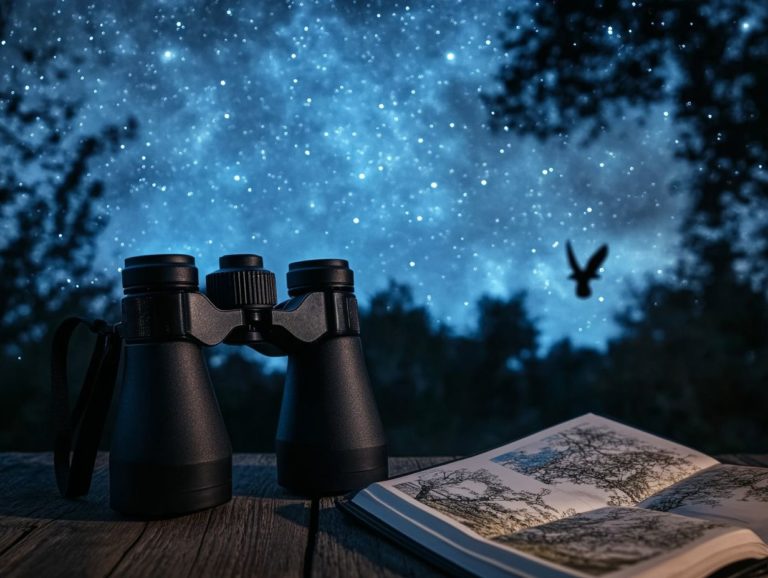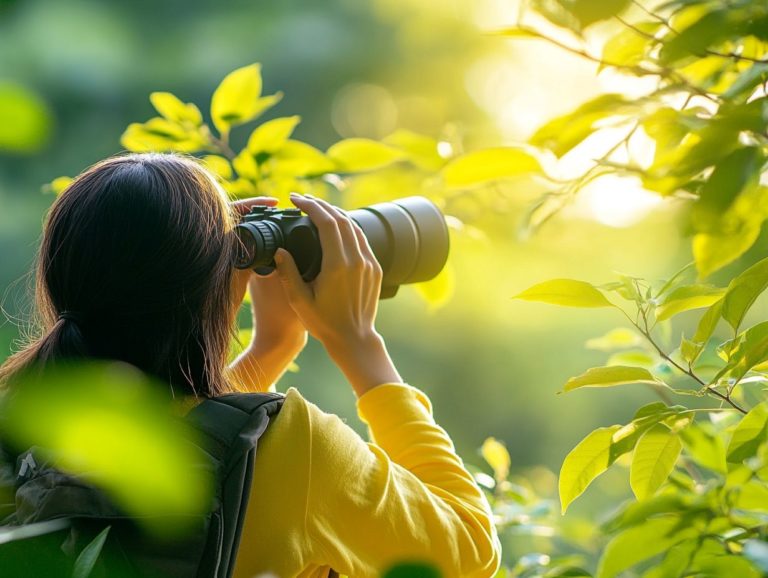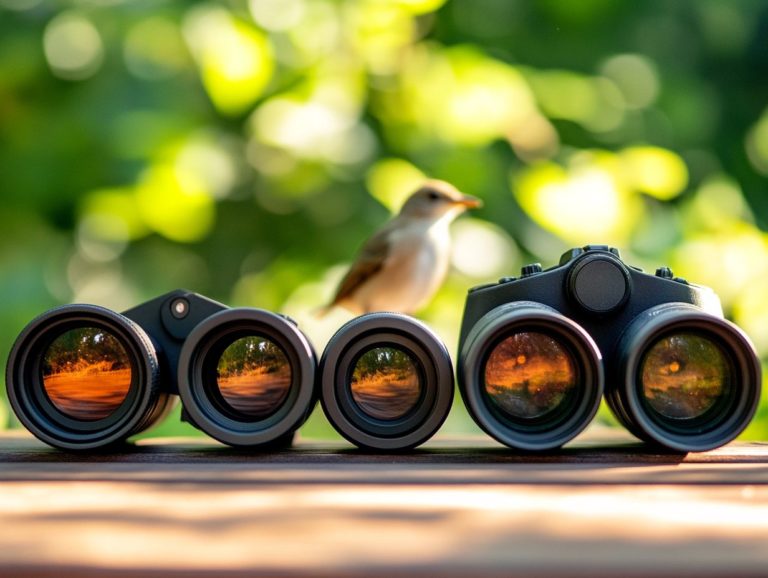Tips for Choosing Binoculars for Bird Photography
Bird photography offers a stunning glimpse into the beauty of nature. The right binoculars can elevate your experience to new heights.
This guide delves into the essential factors to consider when choosing binoculars. It covers everything from size and magnification to optical quality and comfort.
We break down the various types of binoculars that are well-suited for bird photography. You’ll also find practical tips for maximizing their effectiveness.
You’ll find maintenance advice to keep your gear in peak condition.
Whether you’re a seasoned photographer or just beginning your journey, this guide will assist you in selecting the perfect binoculars to enrich your birdwatching adventures.
Contents
- Key Takeaways:
- Factors to Consider When Choosing Binoculars
- Types of Binoculars for Bird Photography
- Tips for Using Binoculars in Bird Photography
- Maintaining and Protecting Your Binoculars
- Frequently Asked Questions
- What should I consider when choosing binoculars for bird photography?
- Are there any specific features I should look for in binoculars for bird photography?
- Should I choose roof or porro prism binoculars for bird photography?
- Do I need to spend a lot of money on binoculars for bird photography?
- Can I use binoculars for bird photography without a camera?
- Is it important to try out binoculars before purchasing?
Key Takeaways:
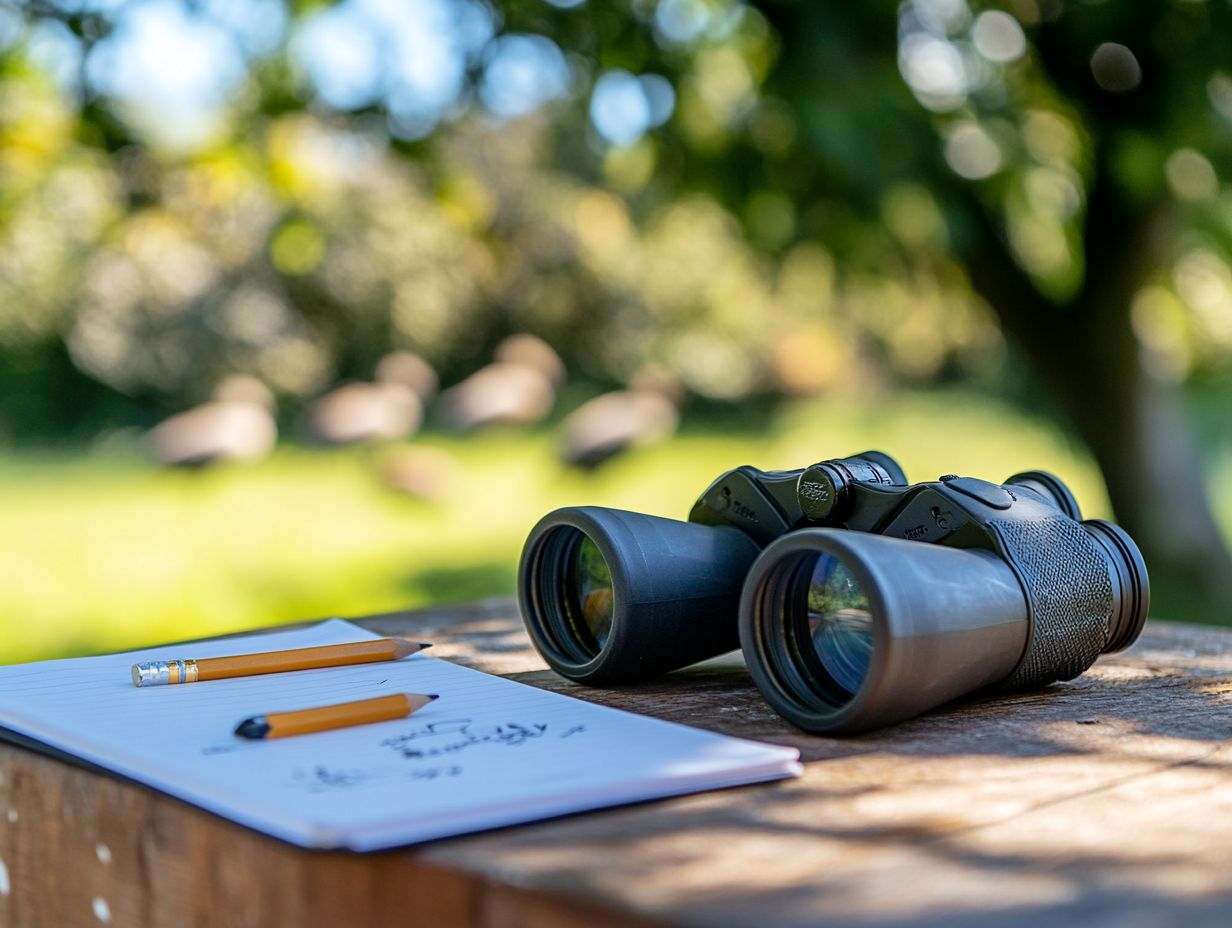
- Consider size, magnification, optical quality, field of view, and weight when choosing binoculars for bird photography.
- Choose between porro prism vs. roof prism and compact vs. full-size binoculars for your needs.
- Proper technique and adjustments for lighting conditions are crucial for getting the best results with your binoculars in bird photography.
Why Use Binoculars for Bird Photography?
Using binoculars for bird photography is essential for anyone serious about enhancing their observation experience. For optimal results, using binoculars effectively for bird identification provides important benefits, such as improved light-gathering capabilities and optical quality. They allow you to focus closely on hard-to-see birds.
They are critical tools in bird conservation efforts. You can appreciate nature from a distance without intruding on their habitats. Whether you’re on a nature walk or attending an ornithological event, the right pair of binoculars is the key to capturing stunning bird photos!
With many options available, features like magnification and field of view significantly influence your experience. Higher magnification lets you zoom in on distant subjects, while a wider field of view helps you quickly track fast-moving birds.
Close focusing capabilities let you examine intricate details, such as feather patterns and vibrant colors. Esteemed organizations like the US Fish and Wildlife Service and the Cornell Lab of Ornithology emphasize that these tools not only enhance your observational skills but also promote responsible birding practices. This fosters conservation through education and awareness.
This blend of features deepens your connection to the avian world and enriches both your photography and your overall appreciation for wildlife.
Factors to Consider When Choosing Binoculars
When selecting binoculars, consider several critical factors to ensure you choose the ideal pair for bird photography and wildlife observation. This includes understanding binocular specifications for birders tailored to your needs.
From magnification options to lightweight designs, understanding specifications like objective lens size and overall configuration is essential for finding the perfect fit tailored to your birding needs.
Size and Magnification
The size and magnification of your binoculars are vital in shaping the quality of your viewing experience, particularly for bird watching. For instance, 8×42 binoculars strike an excellent balance between magnification and field of view. The exit pupil measurement, which is the diameter of the beam of light exiting the binoculars, aids in assessing brightness and clarity during your observations.
Selecting the right magnification can significantly elevate your birding experience. Various activities call for different levels of detail. For example, watching birds in flight may seem appealing with higher magnification; however, it often comes at the cost of field of view and stability.
Experts like Brian Sullivan highlight that a wider field of view allows you to track moving subjects with ease. Glenn Bartley points out that lightweight designs enhance comfort during long hours of observation.
Ultimately, consider the environment and the behaviors you wish to observe, as well as your personal preferences. By doing so, you’ll ensure that the binoculars you choose perfectly complement your specific birding pursuits.
Optical Quality and Coatings
Choose binoculars with a focus on optical quality. This directly affects image clarity, brightness, and color accuracy. Look for binoculars with advanced coatings that enhance light transmission and minimize glare. Waterproof binoculars provide the durability you need for outdoor adventures.
Several types of optical coatings are available, including single-coated, multi-coated, and fully multi-coated. Multi-coated optics balance cost and performance, applying multiple layers of anti-reflective coating to significantly boost light transmission compared to single-coated lenses. For maximum brightness and clarity, opt for fully multi-coated optics, which feature multi-layer coatings on every glass surface.
When comparing top brands like Leica and Canon, you’ll find that Leica excels in color fidelity and sharpness, making it a favorite among serious birdwatchers. Canon, on the other hand, appeals to those seeking versatility and accessibility in optical performance.
Get ready to capture stunning images! Investing in high-quality optics opens the door to breathtaking bird photography that truly stands out.
Field of View and Focus

The field of view and focusing capabilities of binoculars are essential for your birdwatching success. These factors determine how much of the landscape you can see and how swiftly you can zero in on those fast-moving subjects. A wide field of view makes tracking birds in flight effortless, while close focusing allows you to appreciate finer details when birds settle nearby.
Understanding how to measure these specifications is crucial for bird enthusiasts at any skill level. To measure the field of view, look for specs in meters at 1,000 meters or feet at 1,000 yards. This tells you how wide the area you can observe is. Also, pay attention to the minimum focusing distance, which indicates how close you can approach your subject while still maintaining sharp focus.
Since birds can be unpredictable, being able to adjust your focus quickly is vital. A handy technique is to practice on stationary objects, gradually getting used to varying distances. For additional insights, explore resources from the Audubon Society to enrich your birding experience.
Weight and Comfort
When selecting binoculars for birding, weight and comfort are essential factors to consider, especially since you’ll likely be using them for extended periods during nature hikes. Lightweight binoculars significantly reduce fatigue, allowing you to immerse yourself in the beauty of your surroundings instead of wrestling with heavy gear.
Serious birders emphasize the importance of these aspects for peak performance. Take Bill Stewart, for instance an avid birdwatcher who once opted for lightweight binoculars on a long trek. He found that his enjoyment soared when he no longer had to contend with cumbersome equipment.
Patrick Comins shares the importance of ergonomic features. He explains how binoculars crafted with comfort in mind allowed him to observe elusive species for hours without discomfort.
Don’t miss out! Thoughtful design can elevate your birding experience to new heights. Investing in lightweight binoculars and comfortable gear is essential for anyone serious about birding.
Types of Binoculars for Bird Photography
Regarding bird photography, the binoculars you select can profoundly impact your observation experience. Both Porro prism and roof prism designs offer distinct advantages tailored to different needs.
You ll find a wide array of options, from compact binoculars that are easy to carry to full-size models that typically deliver exceptional optical performance and impressive light-gathering capabilities.
Explore our recommendations today and find the perfect binoculars for your next birdwatching adventure!
Porro Prism vs Roof Prism
Porro prism and roof prism binoculars each offer unique characteristics tailored to your birdwatching preferences. You might lean toward Porro prism binoculars for their wider field of view and superior optical performance.
Roof prism designs present a more streamlined option, making them compact and easier to handle. The distinct advantages of these styles can significantly enhance your birdwatching experience.
For instance, models like the Nikon Aculon A211 excel at delivering vibrant colors and improved depth perception, which is essential for spotting elusive birds.
Brands like Zeiss perfect roof prism binoculars, such as the Conquest HD series. These combine lightweight materials with cutting-edge optics, resulting in exceptional image clarity while ensuring portability.
Enjoy your long hours of birdwatching without feeling tired! Ultimately, the choice between these types depends on your personal needs, striking a balance between comfort and the image quality you desire.
Compact vs Full-size
Choosing between compact and full-size binoculars hinges on your specific birdwatching activities and personal preferences. Each type presents its own set of advantages and limitations.
Compact binoculars are lightweight and easily portable, making them perfect for quick outings. In contrast, full-size binoculars excel in light gathering and often deliver superior optical quality.
For casual birding trips where ease of transportation is essential, the compact option may serve you well, allowing for spontaneous adventures without the added bulk.
If you’re a serious photographer or an enthusiast focused on detailed observation, you may prefer full-size binoculars. They offer more clarity and brightness, especially in low-light conditions.
Ultimately, your choice should align with your priorities. If spontaneous excursions and lightweight gear are paramount, compact models will be your go-to. However, for in-depth study and photography, investing in full-size options is a wise decision.
Tips for Using Binoculars in Bird Photography
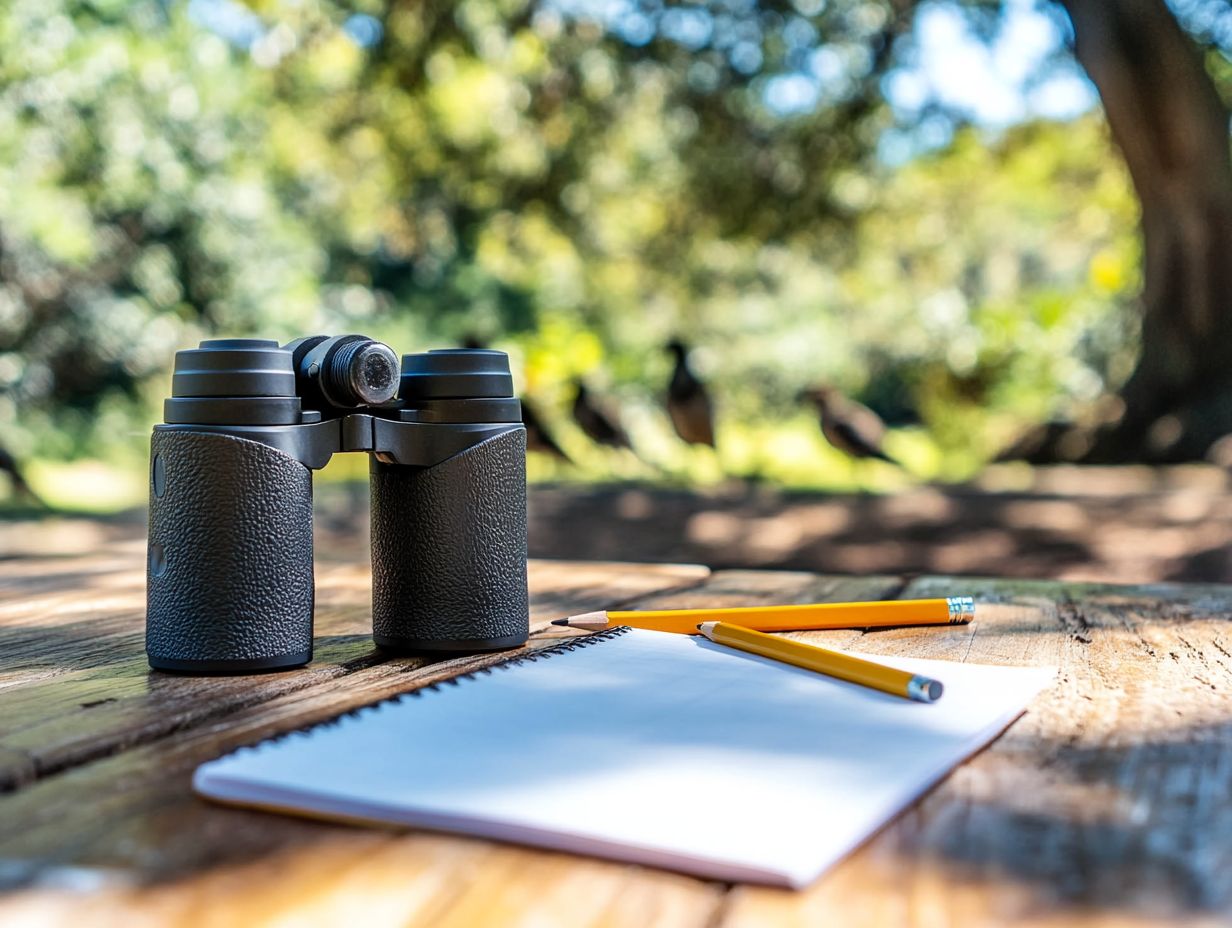
To elevate your bird photography experience, it’s crucial to employ the right techniques and positioning when using binoculars. For those seeking to enhance their viewing experience, consider the top features in bird watching binoculars. This means adjusting your stance, seeking a stable base, and utilizing correct hand positions to maintain stability.
With these practices in place, you’ll be well-equipped to capture vivid images of birds in their natural habitats.
Proper Technique and Positioning
Utilizing proper technique and positioning when using binoculars is essential for capturing clear and detailed bird photographs. For those interested in choosing the right equipment, understanding what makes a great pair of bird watching binoculars can enhance your experience. Adopting a stable stance, along with correct hand positioning and a firm grip, will significantly improve your ability to track moving subjects.
Many photographers suggest anchoring your elbows for better stability, which effectively reduces any unwanted shaking while you focus on distant birds. Maintaining a comfortable and balanced posture enables greater endurance during extended observation periods.
Strategically position yourself perhaps by crouching down or finding a supportive natural feature like a tree branch to achieve ideal viewing angles and minimize strain.
By practicing these techniques, you can elevate your overall experience and lead to better shot compositions, transforming a simple outing into a rewarding photographic adventure. So, grab your binoculars and head out to experience the thrill of birdwatching!
Adjusting for Different Lighting Conditions
Adapting to varying lighting conditions is crucial for achieving stunning results in bird photography with binoculars. Different light levels significantly impact image quality and clarity. By mastering the art of adjusting your settings or techniques based on the time of day or weather, you can elevate your observation experience.
For instance, during bright sunlight, using polarized filters minimizes glare and enhances vibrant colors. On overcast days, you ll find that diffuse lighting provides more even exposure without harsh shadows that can detract from your images.
Attending birding events, such as the Audubon Convention, can be particularly enlightening. These events often highlight practical tips and demonstrate how seasoned birders adjust their settings for optimal viewing. Position yourself strategically to harness natural light. Birds tend to be more active in the early morning and late afternoon when shadows play together, creating breathtaking contrasts.
Maintaining and Protecting Your Binoculars
Proper maintenance and protection of your binoculars are essential for ensuring long-term performance and durability. This is especially important if you’re an avid bird watcher who spends considerable time outdoors.
By implementing regular cleaning and careful storage, you must prevent dust and moisture to keep your binoculars in top shape. This attentive approach safeguards your investment and extends their lifespan, allowing you to enjoy countless moments of nature’s beauty with crystal-clear vision.
Cleaning and Storage Tips
Cleaning and storage are essential elements of binocular maintenance. They ensure you get optimal performance and longevity while safeguarding your investment. By regularly cleaning your lenses and storing your binoculars with care, you can prevent dust and moisture from causing damage.
First things first use the right materials for the job. A microfiber cloth designed specifically for optics is your best bet, as it won’t scratch the lens surfaces. You might consider a lens cleaning solution, but remember to apply it sparingly.
Begin by gently blowing away any dust particles. Then, take that microfiber cloth and use circular motions to wipe the lenses clean. After cleaning, proper storage in a protective case or pouch is a must. This shields your binoculars from environmental hazards like humidity and temperature fluctuations, minimizing the risk of scratches and impact damage.
Investing in a quality case will significantly enhance the longevity of these vital tools, ensuring they remain reliable companions for years to come.
Frequently Asked Questions

What should I consider when choosing binoculars for bird photography?
When choosing binoculars for bird photography, there are several factors to consider. First, look for binoculars with a magnification between 8x and 10x. This range allows you to see details of the birds without making the image too shaky. Additionally, consider following tips for storing your bird watching binoculars to ensure they remain in great condition for your photography needs.
Next, consider the field of view. A wider field of view makes it easier to track moving birds. Finally, look for binoculars with a close focus distance, allowing you to focus on birds that are nearby.
Are there any specific features I should look for in binoculars for bird photography?
Yes, several features can be helpful for bird photography. For instance, understanding the importance of binoculars in birding highlights that options with image stabilization reduce shakiness and make it easier to capture clear images.
Also, look for binoculars with a large exit pupil (the diameter of the beam of light exiting the eyepiece) for better low-light vision, such as during dawn or dusk.
Should I choose roof or porro prism binoculars for bird photography?
Both roof and porro prism binoculars can be suitable for bird photography. However, roof prism binoculars tend to be more compact and lightweight, making them easier to carry around.
On the other hand, porro prism binoculars may offer better image quality due to their design, so it ultimately comes down to personal preference and budget.
Do I need to spend a lot of money on binoculars for bird photography?
Binocular prices for bird photography can vary widely. While pricier models often provide better image quality, you don t need to spend a fortune.
Can I use binoculars for bird photography without a camera?
Yes, binoculars let you enjoy a closer view of birds in their natural habitat. They allow you to appreciate their beauty and behavior up close.
A camera helps capture and preserve those moments for later viewing.
Is it important to try out binoculars before purchasing?
It s a great idea to try binoculars before buying them. This way, you can check their weight, size, and comfort level.
You can also test the image quality to ensure the binoculars fit your needs perfectly!

